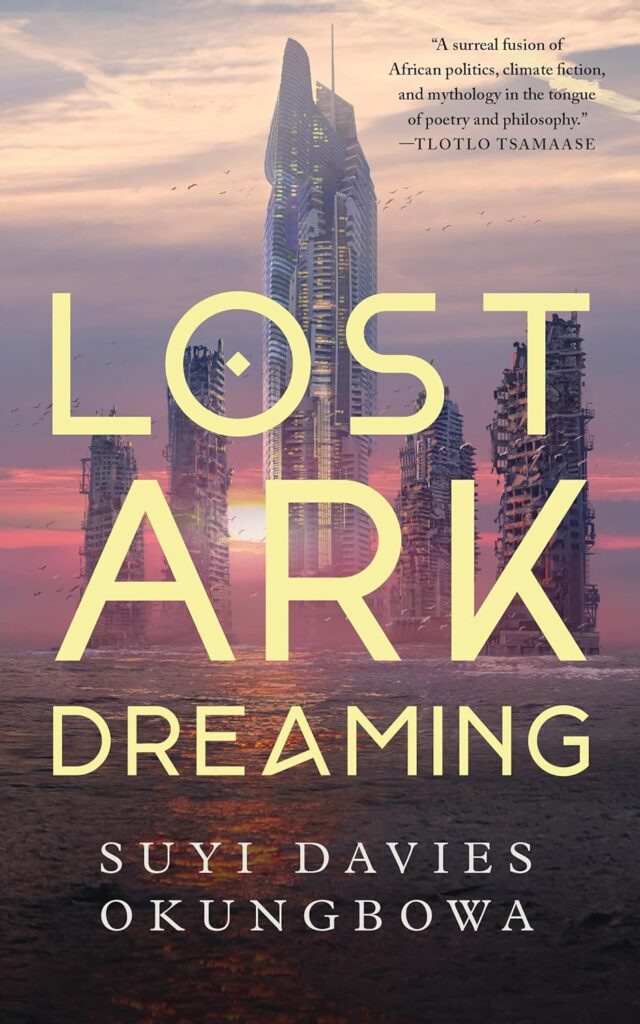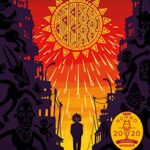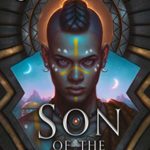“What are we but stories that touch?” This crucial question arises early in one of the poetic interludes of this absorbing novella about the drowning world of a future Lagos – Lost Ark Dreaming by Suyi Davies Okungbowa. While most of the city is now underwater, survivors live in the Pinnacle, highest of five towers built offshore for the wealthy by the Diekara family. Four of these great structures have already failed, and some of the survivors, including the grandparents of the central character, Yekini, have managed to rebuild their lives in this last great tower.
This is a powerful story about the nature of story itself, of myth, of memory, of belief shaped by propaganda, of hope arising from the willingness to risk privilege for truth, and the critical choices that must be made when reality overturns a rigidly imposed hierarchy of status and value.
Lost Ark Dreaming begins appropriately enough with a dream. Yekini sees a great Ark, helmed by a robed figure resembling at times Olokun, god of the sea, or Noah or Deucalion or any great survivor figure of a world flood, who is reaching for a basket Yekini holds. In the basket is a baby with her face or the face of someone she knows whom she could choose to save, but she clings to the basket as the waters are rising over Lagos. Then she awakens to the mundane world of her middle level apartment and realizes that she has slept late. She lives in the Pinnacle where she looks after her Maame and needs to rush to her job as an analyst for the Commission that runs the huge tower.
Yekini’s story touches those of Ngozi and Tuoyo when the three are assigned to deal with a difficult problem on one of the lower, submerged levels of the Pinnacle. There has been a dangerous breech in a wall that holds back the sea. The rigidly stratified social life of the tower is reflected in the careers of these characters. Yekini, whose family climbed slowly from the undersea Lowers to the Midders, is an analyst now assigned to her first field problem. But since it’s at an undersea level, she interprets it as a kind of punishment for some unknown offense. Tuoyo is a mechanic and foreman of the level where the breech occurred and who has never really recovered from the death of her wife at sea. Ngozi is a higher status bureaucrat from the Upper levels, who can’t understand why he has to endure an embarrassing assignment in the undersea levels.
Together these three have to investigate that most dreaded of problems, a breech in one of the sluice gates used to flood the airlocks for underwater exits. Could it be that one of the non-human sea creatures, known as Children, could have slipped inside? These monstrous beings claimed the lives of Tuoyo’s wife and probably of Yekini’s parents. Yet there are no signs of an invader, and the three start searching the level for evidence. What follows is a tightly constructed story, told through the eyes of these three characters as well as through various reports and interludes of beautiful poetry.
The world of the Pinnacle is carefully delineated, mostly through the regimentation of the life of the “towerzens” whose existence is circumscribed by the level they have managed to reach. The lowest classes are those dwelling below sea level, where they lack sunlight and endure a heavy, moist atmosphere. Many like Yekini’s family managed to move up to the Midder level with its more pleasant living conditions but also regimented by the power of the rulers at the upper levels. Ngozi, living on an upper level, has an official status that gives him access to all the facilities at lower levels, but he is forever worried about losing the status he has fought so hard to attain.
As the hastily assembled trio of Tuoyo, Yekini and Ngozi start searching for evidence of what has happened at the lower level where the breech occurred, they are never sure what they are looking for. Thanks to the propaganda feeds circulated by the rulers of the Pinnacle, Yekini had:
“a clear sense of the threat posed to Pinnacle dwellers, but not of who [the] Children were or why they even posed such a threat. Some people thought of them as monster-ghosts who could slip through walls. Some thought of them as magma-spitting demons, complete with tentacles and horns. Some thought of them as shape-shifting ancient warriors with shark-like teeth. …
Lost Ark Dreaming, Advance Kindle review copy, Locations 448-453
The only thing everyone agreed upon was that they looked obviously humanlike and could pass for one. The trick was to check their hands and feet for webbing, and behind their ears for gills. Yekini found all of this odd: How could one check for such when everyone agreed that Children could not survive outside of water?”
Okungbowa weaves a beautiful story, with echoes of Rivers Solomon’s The Deep, that gives a whole new meaning to the trope of human society surviving catastrophe through life in towering buildings. It is a story that brings us to a powerful moment of human choice, referring back in an image to the first dream of Yekini. It is a fully satisfying climax that pulls all the strands of the story together and which could either lead to a sequel or simply end where it does. Either way, the poetry and myth blend beautifully with the action of a strong adventure. Lost Ark Dreaming is a remarkable piece of writing.
My thanks to Tordotcom and Netgalley for an advance copy of Lost Ark Dreaming on which to base this review, reflecting solely my own opinions.





Leave a Reply